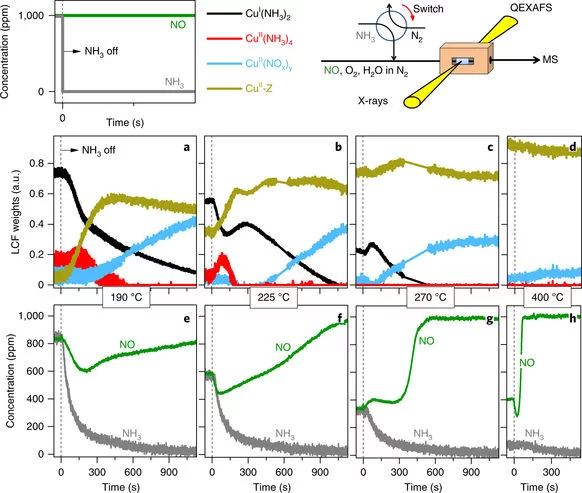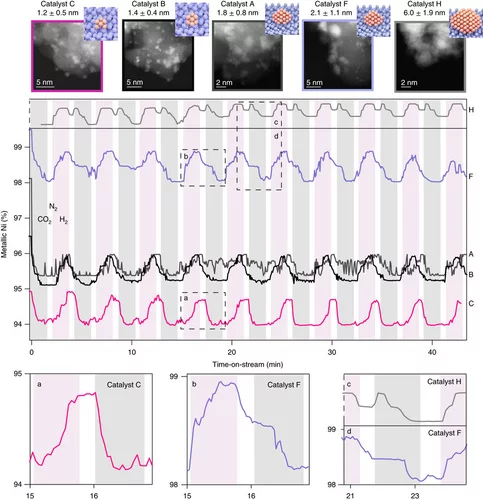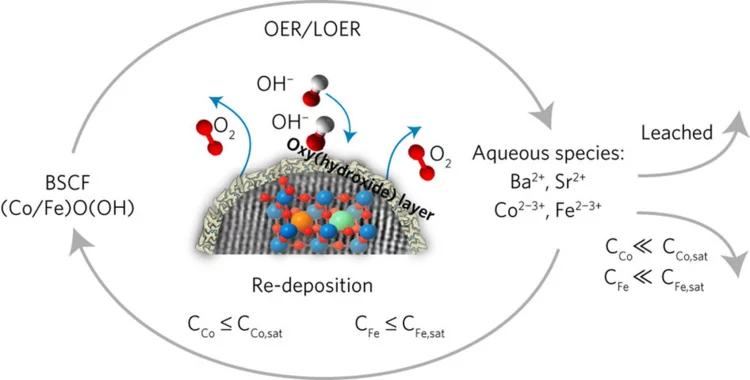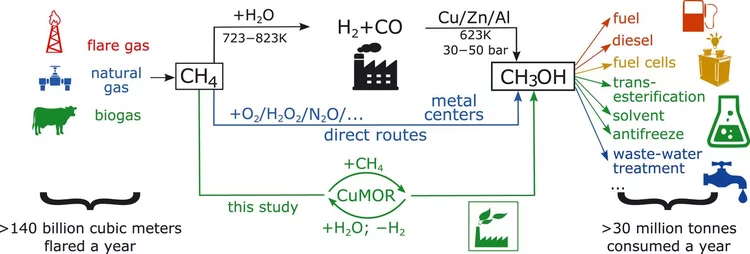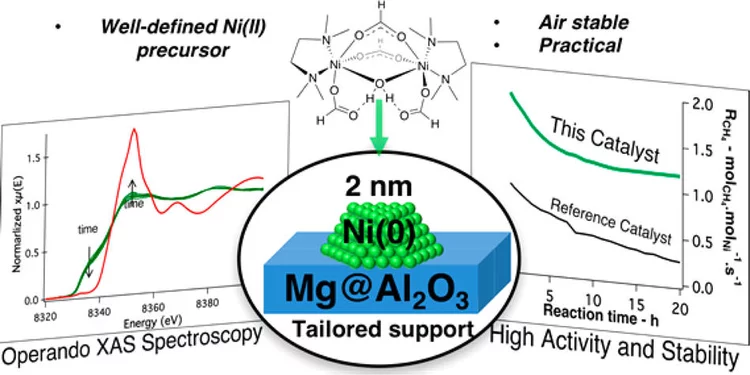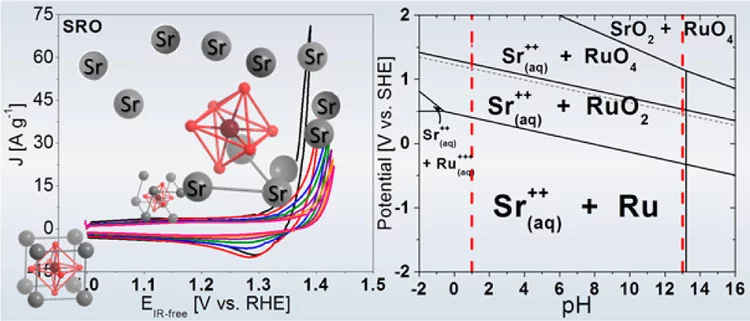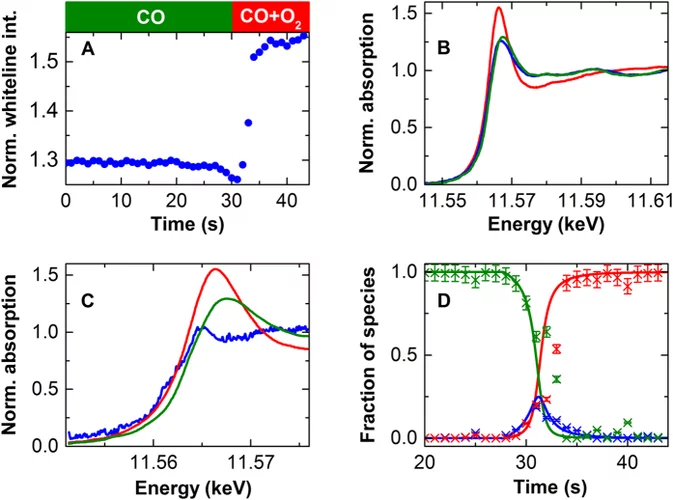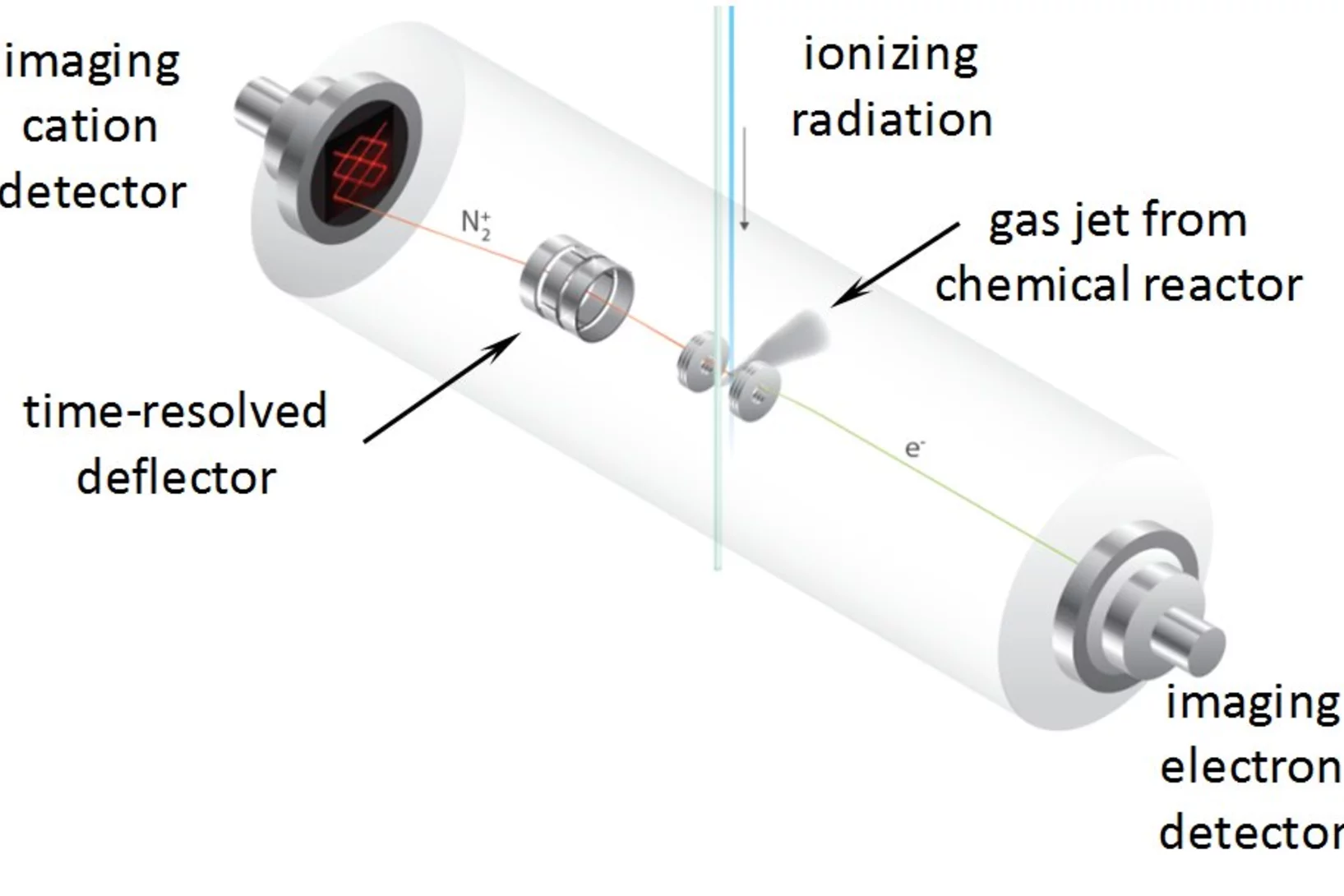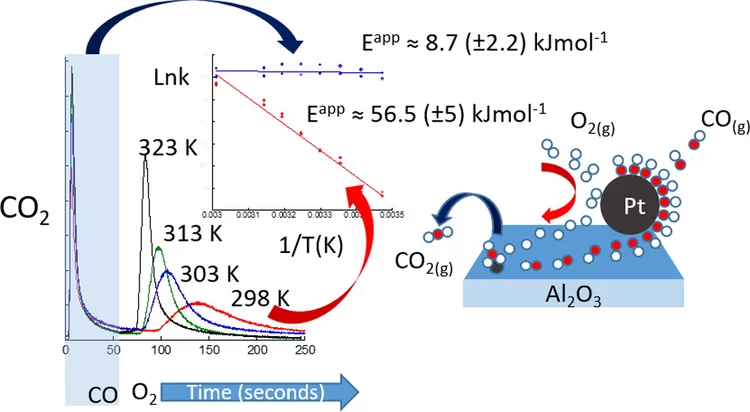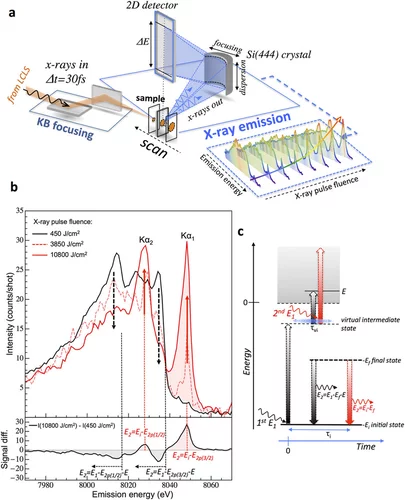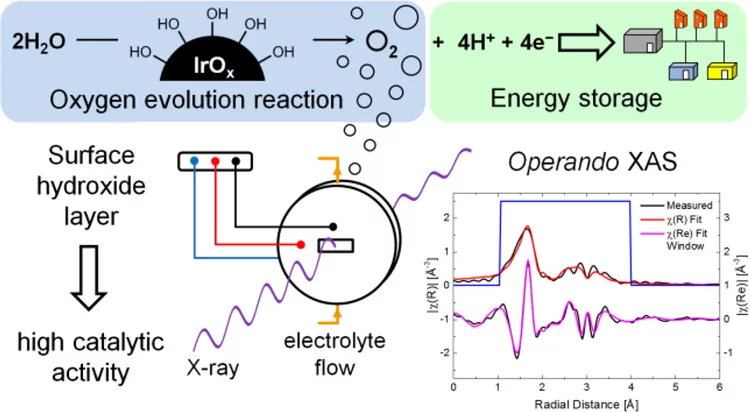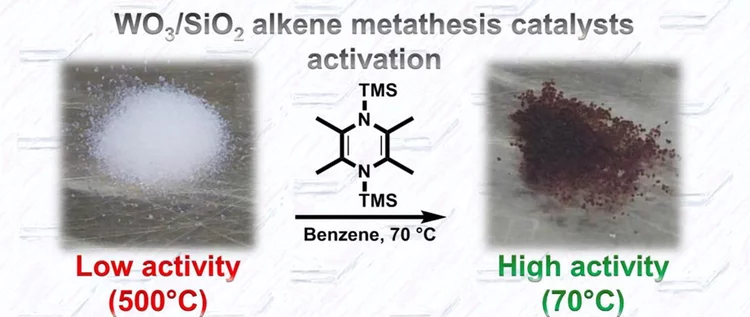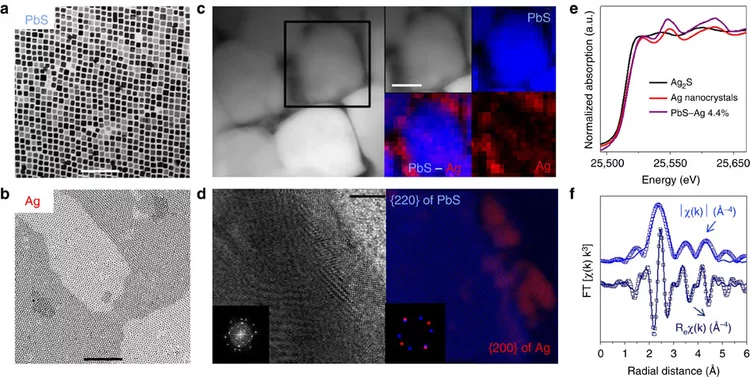Time-resolved copper speciation during selective catalytic reduction of NO on Cu-SSZ-13
Through the combination of time-resolved X-ray absorption spectroscopy and transient experimentation, we were able to capture an ammonia inhibition effect on the rate-limiting copper re-oxidation at low temperature.
Are supersaturated calcium carbonate solutions classical or non-classical ?
Classical theory predicts that supersaturated carbonate solutions consist mostly of ions and ion pairs, with a small number of larger clusters present in the solution. The population of the different sized clusters in a solution is solely defined by the cluster’s size dependent Free Energy. If clusters are large enough they serve as nucleation germs for a new solid phase. The nucleation occurs once the surface free energy barrier posed by the new solid-liquid interface is overcome by the free energy win from bulk phase growth.
Unravelling structure sensitivity in CO2 hydrogenation over nickel
Using a unique set of well-defined silica-supported Ni nanoclusters (1–7 nm) and advanced characterization methods it was proved how structure sensitivity influences the mechanism of catalytic CO2 reduction, the nature of which has been long debated.
Making the world go round - a look into the structure of a prominent heterogeneous catalyst
Fluid catalytic cracking catalysts, which are composite particles of hierarchical porosity, were examined using ptychographic X-ray tomography. These particles are essential to the conversion of crude oil into gasoline. Examination of catalysts at decreasing levels of catalytic conversion efficacy allowed the detection of possible deactivation causes.
Chemical Imaging to Spy on Malaria Parasites
Unique insights into the adolescence and metabolism of a Malaria parasite in a human red blood cell are obtained by a new chemical imaging methodology – in situ correlative X-ray fluorescence microscopy and soft X-ray tomography.
Nanomaterial helps store solar energy: efficiently and inexpensively
By combining a scalable cutting-edge synthesis method with time-resolved X-ray absorption spectroscopy measurements, it was possible to capture the dynamic local electronic and geometric structure during realistic operando conditions for highly active OER perovskite nanocatalysts.
Understanding the reaction mechanism in lignin catalytic fast pyrolysis
Lignin is a major constituent of plants, and may be used as a precursor for fuels and fine chemicals. Catalytic fast pyrolysis of lignin is one of the most promising approaches. By using vacuum ultraviolet synchrotron radiation and threshold photoelectron spectroscopy we could identify elusive intermediates, which are responsible for the formation of phenol and benzene and could thus tackle this reaction mechanism. Mechanistic understanding could enable targeted improvement of production methods in the future, beyond the currently used "cook-and-look" approach.
Isomer-Selective Generation and Spectroscopic Characterization of Biofuel Intermediates
Online combustion analysis relies heavily on spectral data to detect reactive intermediates isomer-selectively to establish e.g. kinetic flame models. Due to the difficulty to generate these species cleanly, spectral data are rather scarce. Here we report on the selective generation of three picolyl radical isomers (C5H4N-CH2*) by deamination of aminomethylpyridines. Picolyl radicals are relevant in biofuel combustion, and could now be characterized by threshold photoelectron spectroscopy using synchrotron radiation. Vibrationally resolved bands and distinct ionization energies allow for isomer-specific detection of these elusive species in complex environments and permit us to explore new avenues in soot- and NOx formation kinetics.
Fate of Plutonium through a Geological Reactive Barrier
Natural geological and engineered barriers play a key role in protecting the environment and the anthroposphere from the hazardous impact of deposited waste or spreading contaminants. Such natural geological and engineered barrier materials are commonly complex and heterogeneous. In-situ multimodal microscopic studies under conditions relevant to deep geological formations are crucial to identify the reactive components and reaction pathways or to validate proposed immobilization mechanisms. The present study demonstrated that a simplistic description by a sole reactive component is not an adequate representation of the geochemical reactivity responsible for the immobilization of plutonium within a natural Clay Rock barrier. Multimodal chemical imaging studies on intact, undisturbed systems are absolutely essential to ascertain the geochemical reactivity for relevant geochemical conditions and settings.
Selective anaerobic oxidation of methane enables direct synthesis of methanol
On the basis of in situ x-ray absorption spectroscopy, infrared spectroscopy, and density functional theory calculations, it was proposed a mechanism involving methane oxidation at Cu II oxide active centers, followed by Cu I reoxidation by water with concurrent formation of hydrogen.
Molecularly Tailored Nickel Precursor and Support Yield a Stable Methane Dry Reforming Catalyst with Superior Metal Utilization
The superior performance of molecularly tailored methane dry reforming catalyst resulted in a maximization of the amount of accessible metallic nickel in the form of small nanoparticles preventing coke deposition. Operando X-ray absorption near-edge structure spectroscopy confirms that deactivation largely occurs through the migration of Ni into the support.
Unraveling Thermodynamics, Stability, and Oxygen Evolution Activity of Strontium Ruthenium Perovskite Oxide
Ru-based perovskites, i.e. SrRuO3 and LaRuO3, have been predicted as active perovskites to exhibit a particularly high oxygen evolution reaction activity. We highlight that understanding the origin of stability under a real operating environment is absolutely essential for the design of a sustainable electrocatalyst with optimal balance between activity and stability.
IrO2‑TiO2: A High-Surface-Area, Active, and Stable Electrocatalyst for the Oxygen Evolution Reaction
We have developed a synthetic approach to highsurface-area chlorine-free iridium oxide nanoparticles dispersed in titania (IrO2-TiO2), which is a highly active and stable OER catalyst in acidic media. Operando X-ray absorption studies demonstrate the evolution of the surface species as a function of the applied potential, suggesting the conversion of the initial hydroxo surface layer to the oxo-terminated surface via anodic oxidation.
Detecting and utilizing minority phases in heterogeneous catalysis
Highly active phases in carbon monoxide oxidation are known, however they are transient in nature. Here, we determined for the first time the structure of such a highly active phase on platinum nanoparticles in an actual reactor.
Breaking Through the False Coincidence Barrier in Electron–Ion Coincidence Experiments
The false coincidence background has so far limited the analytical application of PEPICO, photoelectron photoion coincidence. A new photoioin rastering technique has been developed to separate the wheat from the chaff and identify true coincidences based on the ion hit time and position. This expands the dynamic range of the experiment by at least two orders of magnitude, allowing for novel applications to look for reactive intermediates and short lived species in reaction environments.
C–H Activation on Co,O Sites: Isolated Surface Sites versus Molecular Analogs
The activation and conversion of hydrocarbons is one of the most important challenges in chemistry. This work shows that isolated Co(II) sites are catalysts for a number of hydrocarbon conversion reactions, such as the dehydrogenation of propane, the hydrogenation of propene, and the trimerization of terminal alkynes. The data are consistent with all of these reactions occurring by a common mechanism, involving heterolytic C–H or H–H activation via a 1,2 addition across a Co–O bond.
Kinetic studies of the Pt carbonate-mediated, room-temperature oxidation of carbon monoxide by oxygen over Pt/Al2O3 using combined, time-resolved XAFS, DRIFTS, and mass spectrometry
The kinetics involved in novel ambient-temperature mechanism for the catalytic oxidation of carbon monoxide by oxygen over a Pt/Al2O3 catalyst is evaluated within a periodic redox operation paradigm using combined mass spectrometry (MS), diffuse reflectance infrared spectroscopy (DRIFTS), and time-resolved Pt L3-edge XAFS. A high-wavenumber (ca. 1690 cm-1) carbonate species are shown to be associated with a room-temperature redox process occurring in a fraction of the Pt atoms present in the catalyst.
Establishing nonlinearity thresholds with ultraintense X-ray pulses
The advent of X-ray free electron lasers (XFELs) is opening the ability to reach extremely high photon numbers within ultrashort X-ray pulse durations and is leading to a paradigm shift in our ability to explore nonlinear X-ray signals.
Iridium Oxide for the Oxygen Evolution Reaction: Correlation between Particle Size, Morphology, and the Surface Hydroxo Layer from Operando XAS
A simple and scalable method for preparation of well-defined chlorine–free iridium oxide nanoparticles active for oxygen evolution reaction (OER) was developed. Operando X-ray absorption spectroscopy and X-ray photoelectron spectroscopy indicate that OER activity is strongly related to the presence of iridium hydroxo (Ir–OH) species on the surface of iridium oxide nanoparticles.
The chemical state of 79Se in spent nuclear fuel
An interdisciplinary study conducted at different PSI laboratories (LES,AHL, LRS, SYN) in collaboration with Studsvik AB (Sweden) demonstrates that selenium originating from fission in light water reactors is tightly bound in the crystal lattice of UO2. This finding has positive consequences for the safety assessment of high-level radioactive waste repository planned in Switzerland, as it implies (contrary to previous assumptions) that the safety-relevant radionuclide 79Se will be released at extremely low rates during aqueous corrosion of the waste in a deep-seated repository.By Enzo Curti (PSI-LES)
Low temperature activation of supported metathesis catalysts by organosilicon reducing agents
Industrial alkene metathesis processes rely on silica-supported tungsten oxide catalysts, which operate at high temperatures (>350 °C) due to the difficulty in generating active sites (carbenes or metallacyclobutanes). We report here a low temperature activation process of well-defined metal oxo surface species using organosilicon reductants, which generate a large amount of active species at only 70 °C (0.6 active sites/W).
Researchers find key to zinc rich plants to combat malnutrition
The diet in many developing countries is lacking zinc, but researchers have just solved the riddle of how to get more zinc into crop seeds. The discovery has been published in Nature Plants, and the research was led by University of Copenhagen.By Johanne Uhrenholt Kusnitzoff
Watching lithium move in battery materials
In order to understand limitations in current battery materials and systematically engineer better ones, it is helpful to be able to directly visualize the lithium dynamics in materials during battery charge and discharge. Researchers at ETH Zurich and Paul Scherrer Institute have demonstrated a way to do this.
High-performance thermoelectric nanocomposites from nanocrystal building blocks
Using an assembly of colloidal nanocrystals a Ag-PbS nanocomposite was produced with increased thermoelectic figures of merit up to 1.7K at 850 K. EXAFS spectroscopy at the Ag K-edge was essential to show that Ag does not dissolve in PbS nanoparticles but preserved the individual nanodomains. This reduces the PbS intergrain energy barriers for charge transport
Controlling tunnelling in methane loss from acetone ions by deuteration
At the imaging Photoelectron Photoion Coincidence (iPEPICO) endstation of the VUV beamline evidence of H-atom tunneling was shown.
La structure de la maladie du béton
a été décryptée
Quand ponts, barrages et autres ouvrages en béton se retrouvent striés de fissures sombres au bout de quelques décennies, c’est que la maladie du béton est à l’œuvre. Des chercheurs de l’Institut Paul Scherrer PSI et de l’Empa viennent de réussir à décrypter au niveau atomique la composition du matériau qui apparaît dans ces fissures. Ils ont découvert un agencement atomique cristallin, inconnu à ce jour.

